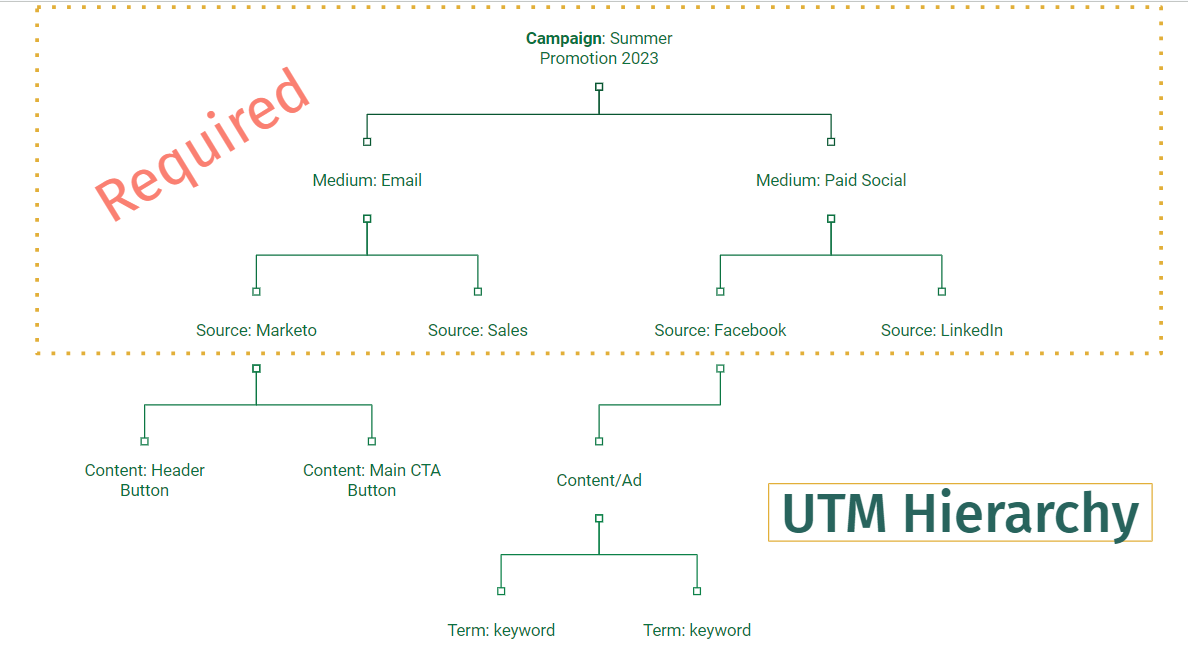In the ever-evolving landscape of digital marketing, data is king. Marketers need precise insights into the performance of their campaigns to make informed decisions and allocate resources effectively. This is where Urchin Tracking Modules (UTMs) step into the spotlight as an indispensable part of your digital marketing toolkit. In this post, we’ll delve into the who, what, where, when, and why of UTMs, explore best practices, and tie it all together to demonstrate their crucial role in modern marketing.
The Who, What, Where, When, and Why of UTMs
What Are UTMs?
UTMs, short for Urchin Tracking Modules, are parameters added to URLs to track and collect data about the source and effectiveness of online marketing efforts. They provide a standardized way of categorizing and attributing traffic and conversions to specific marketing initiatives.
- Channel (medium)
- Vendor (source)
- Marketing initiative (campaign)
- Type (content)
- Keywords (term)

Who Uses UTMs?
UTMs are used by marketers, advertisers, and website owners seeking to gain granular insights into their digital marketing campaigns. Whether you’re running a small e-commerce store or managing the online presence of a multinational corporation, UTMs can be tailored to your needs.
Where Are UTMs Applied?
UTMs are added to the end of URLs in various online marketing channels, including email campaigns, social media posts, pay-per-click ads, and more. They allow you to monitor and measure the performance of each individual link.
When to Use UTMs?
UTMs should be set up and applied before launching a marketing campaign. Proper planning and implementation ensure that you can track and analyze the campaign’s performance from the moment it goes live.
Why Use UTMs?
The importance of UTMs cannot be overstated. They serve several critical purposes in the world of digital marketing:
- Tracking Campaign Performance: UTMs enable you to determine which marketing campaigns are driving the most traffic and conversions. This information helps you optimize your marketing budget and efforts.
- Identifying Traffic Sources: UTMs provide insights into where your website traffic is coming from. You can distinguish between traffic from social media, email marketing, paid advertising, organic search, and more.
- Measuring ROI: UTMs allow you to attribute specific traffic and conversions to particular campaigns, enabling you to calculate the return on investment (ROI) for each marketing initiative.
- A/B Testing: UTMs facilitate A/B testing by enabling you to create multiple UTM-tracked links with slight variations. This helps you compare the performance of different versions of the same campaign.
- Optimizing Content: Analyzing UTM data reveals which types of content or platforms are most effective at driving traffic and engagement, allowing you to fine-tune your future marketing strategies.
Best Practices for UTM Usage
Now that we understand the significance of UTMs let’s explore some best practices to maximize their effectiveness:
- Consistent Naming Conventions: Establish a standardized naming convention for your UTM parameters. Consistency ensures that your data is organized and easy to analyze.
- Documentation Is Key: Maintain documentation detailing the purpose and usage of each UTM parameter. This ensures that your team understands how to use UTMs effectively and consistently.
- Avoid Over-Tagging: Don’t overuse UTMs by tagging every link. Use them strategically for tracking specific marketing campaigns, promotions, or initiatives.
- Regularly Review and Clean Up: Periodically review and clean up your UTM parameters. Remove outdated or unused UTMs to maintain data accuracy and prevent clutter.
- No Internal UTM Tagging: Do not tag internal links/forms with UTMs as that will disrupt the attribution given to what really drove the person to your site
Tying It All Together
Imagine Company A launching a new product. They promote it across multiple channels, each with its own UTM parameters:
- Link 1: UTM Medium = paid-search, UTM Source = google, UTM Campaign = product-launch-fy23
- Link 2: UTM Medium = organic-social, UTM Source = facebook, UTM Campaign = product-launch-fy23
- Link 3: UTM Medium = public-relations, UTM Source = businesswire, UTM Campaign = product-launch-fy23
With UTMs, Company A can precisely track the performance of each link, discerning which channel and campaign is driving the most traffic and conversions. This level of insight is nearly impossible without UTMs. It’s the difference between informed decision-making and marketing in the dark.
 In conclusion, UTMs are a fundamental tool in the modern marketer’s arsenal. They empower you to measure, analyze, and optimize your digital marketing efforts with precision. By following best practices and consistently implementing UTMs, you can unlock a wealth of data-driven insights that lead to more effective and efficient campaigns. Remember, in the world of digital marketing, “one does not simply get campaign credit without UTMs.”
In conclusion, UTMs are a fundamental tool in the modern marketer’s arsenal. They empower you to measure, analyze, and optimize your digital marketing efforts with precision. By following best practices and consistently implementing UTMs, you can unlock a wealth of data-driven insights that lead to more effective and efficient campaigns. Remember, in the world of digital marketing, “one does not simply get campaign credit without UTMs.”
* Need help developing a UTM generator? Download our Campaign Strategy 101 Kit to get your own free UTM Generator!
** Want an audit of your UTM process or person source process to ensure that your strategy is meeting your organization’s goals? Let’s chat!







